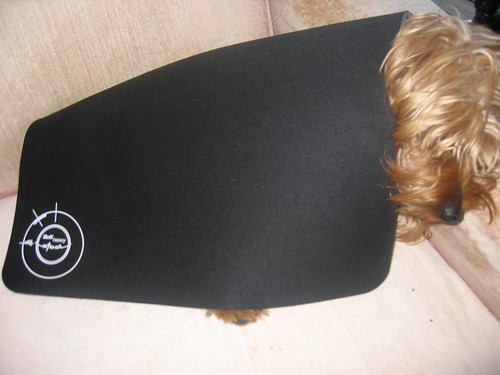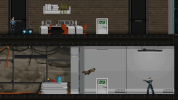GUNPOINT
A stealth puzzle game that lets you rewire its levels to trick people.
Mailing List
Find out when we release a new game, and get invited to closed beta tests.

Sign up here
Release
Out now! $10!
Platform
Windows, Mac and Linux.
Problems?
Tell us about it! Literally do tell us about it, or nothing will happen.
Yes, You Can Monetise Videos You Make Of This Game
Here's the formal permission bit.
Other Projects
Here's a page about what else I'm working on and what else I've done.
Team
Design/Code/Words
Character/Level Art
Background Art
Mission Music
Title Music
Menu Music
Theme
By Tom Francis. Uses Adaptive Images by Matt Wilcox.
Gunpoint And The Other Game
I had an idea for another game, recently. It’s an RTS that would solve a lot of my main frustrations with RTSs, with a few fairly simple mechanics. And it’s an idea that keeps spawning other, smaller ideas, and suggesting parts of itself I might like to cut out to make it even simpler and better.
It’s gamey in a way that Gunpoint isn’t, in that it’s really just a few basic systems: no context, story or even content would be necessary for it to work on a basic level. And it might actually appeal to people outside of my skull, in a way that Gunpoint probably won’t. No logic or thought went into my choice of a jumpy platformer about a private detective for my first game, it was just the first idea that interested me. The RTS feels like something worth making, and something that someone else will probably make if I don’t.
In other words, everything’s been telling me to just stop making Gunpoint, learn Unity, and switch to this newer, better, more potentially successful idea.
I’m not going to. Abandoning an old idea doesn’t solve the problem of forever having newer, better ideas. They’re always going to come faster than you can make them, and for a while, they’re always going to make your old ones seem less exciting. Whatever you do in response to that is what you’re always going to do, so if I ditch Gunpoint to make this RTS, I’d ditch the RTS to make the RPG idea I’m inevitably going to have in six week’s time.
But going back to Gunpoint is harder now. Not because it’s an unexciting idea – the thing at the heart of Gunpoint, which I haven’t really talked about yet, still gets me totally fired up. But looking at it after this gleamingly simple, efficient new idea, it looked incredibly flabby, unfocused, and most of all daunting. I just don’t know how I’m going to do half this stuff, and some of it doesn’t seem very connected to what I’ve done so far.
I’ve tried to simplify Gunpoint lots of times, but I’ve never really questioned that it was going to be story-driven. It couldn’t just be missions, it had to be punctuated with scripted sequences, major characters and predetermined developments.
But that wasn’t really a design choice. I just automatically included it because I’d already written a bunch of scenes, dialogue and characters to flesh out the world in my head. It’s instinctive to write that kind of stuff when you’re thinking up a new world, and useful too. But I should have taken an extra step back and thought, “OK, why do I need to tell these stories to the player? And how much work is it going to be?”
 I don’t have any new screenshots to show you. Here are some horses.
I don’t have any new screenshots to show you. Here are some horses.Now that I take a more squinty-eyed look at the roadmap ahead, I start to see just how much coding each one of these things is, and how little it adds to the game as a game. Making non-interactive scenes on top of your interactive ones is like making a second game – a shitty game no-one can play. And I know from editing GTA IV movies that I’m an obsessively redactive director: I’d never quite be happy with the way they played out.
So I’m scrapping all the non-interactive stuff. There’ll still be story context for each mission, but it’ll be the text of the briefing you choose from some kind of job listings site, and text message conversations with the client.
Oddly, since restricting myself to this for practical reasons, I’ve found it also makes more story sense: you’re a private agent specialising in illegal activities, so you probably would get your jobs from an anonymous site rather than walk-in clients, and communicate by text rather than in person.
It was an easy choice to make – I don’t have to delete anything, because the stuff I’m scrapping is stuff I haven’t made yet. I probably would have given up on a lot of it when I did come to build it. But what the other game has helped me do is clear it out now, while I’m working on the cool stuff. I had to make Gunpoint a more appealing thing to work on, and that meant cutting reams of big wibbly translucent flab until I could see the route to completing it. It clears the head, brings the game into focus, and makes it feel achievable.
 Shrug.
Shrug.I’m always asking developers what they’ve learned from previous games, and sometimes they draw a blank. So I might start ending my Gunpoint diaries with a summary of what I’ve finally figured out.
Writers shouldn’t write games. Designers should give them a little box to write in, and they should write in that. I left my writer hat on way too long after coming up with a vague idea for the world of Gunpoint, and started writing the actual game. “This happens, then this happens, then you get this item-” Shut up! Games aren’t just first person movies, Tom. Design a thing that is fun, then write whatever story context that design needs.
‘Hard to do’ and ‘easy to do’ are irrelevant, ‘good value’ and ‘bad value’ are what matters. I say the story stuff was going to be hard to implement – it wouldn’t be, really. Not as hard as the central mechanic I’ve yet to start on. The difference is, if the central mechanic works, it’ll lead to dozens or even hundreds of fun interactions for each player. The story stuff would be fun a maximum of one time per player, likely not even that. It’s phenomenally bad value. If you’re Valve, and there’s some reason you really want to push this stuff, you can afford that. But if you’re one guy with no experience making games, you can’t.
Unrelatedly: Machine of Death day is in about eight hours. I’ve put together a post about how you can get it, what the postage will cost, and what other forms it’s going to be available in. That’ll go up once it’s officially MOD-Day.
More Gunpoint
ERGlabs:
The new screenshots! They look so real!
Dave:
I had all of these problems back when I first started out as an independent developer. It’s true that when you start to grow out of them you tend to call into question a lot of your early work, but you’ve definitely made the right decision by incorporating these new perspectives without throwing out what you’ve done and starting from scratch.
That said, prototyping is the best method I know for exploring and developing these new ideas without drawing too much time away from the main project, and Unity has allowed me to do this ten times more effectively than any engine I’ve worked with before. It’s tempting to try and work out a lot of the design on paper, but I’ve found that you really can’t predict the way the system will work out, especially if it’s a series of simple and elegant mechanics that you’re working on.
My advice is to start working more with unity and to cultivate these new ideas in the engine. It won’t take nearly as long as you might imagine and the payoff will be much greater than if you simply put them aside for the sake of the main project.
Headwoünd:
*sniff* They grow up so fast.
I’m kidding – only got 2 small projects under my own belt, and it is so easy to add tons and tons of essentially useless stuff onto it. Luckily, I was in charge and I love love love cutting flab. Saying ‘no’ makes me giddy.
Anyway, way to be a tease about the RTS. Though I’d love to see Gunpoint reach at least beta.
Hey Tom, all the best to you for the new game.
I’m still pretty new as a games developer (mostly just doing quirky Flash games!), but I know exactly what you mean when you mentioned the “new ideas keep coming in” thing. Just to share, what I usually do is keep a separate list of future ideas, update the list when inspiration strikes, and actually FINISH the game I’m working on first.
These days, I only abandon the games when the prototype is not much fun, and this method allows me to focus on the current project without feeling like I’m missing out on a cool new idea. It’s on a list, and I’ll eventually get around to it.
Of course, you have a lot more experience than me and you probably know that already. :D
Andrew!:
Another problem is that developers get so close to their mechanics they forget that they need to give new players a way to understand those mechanics, and story is a fairly universal way in. I reckon.
Jason L:
OK, I’ve possibly heard about the RTS via the podcast. Surely it must be called either Gunbutter or Buttergun?
Ah, that’s not the idea, though I do want to make that one too. That would be a good exploratory game to make before doing a proper RTS, because I think it’d be really informative.
For those who didn’t catch it, it was an RTS where you just have one giant blob called ‘Economy’, and one blob called ‘Army’, and you tweak a slider to decide what percentage of your resources to devote to increasing each one. And to prevent extreme early rushes, your economy has a gun on it.
I’ve since decided it should have rudimentary fog of war, and your army should have its own sliders for unit composition. It’s basically a weaponised pie chart, and you drag sliders to determine how much of it is Rocks, Paper and Scissors.








